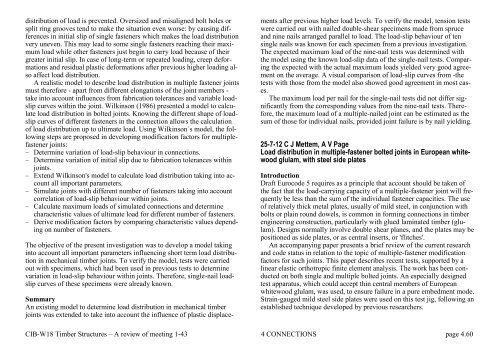Download pdf - CIB-W18
Download pdf - CIB-W18
Download pdf - CIB-W18
- TAGS
- download
- cib-w18.com
Create successful ePaper yourself
Turn your PDF publications into a flip-book with our unique Google optimized e-Paper software.
distribution of load is prevented. Oversized and misaligned bolt holes or<br />
split ring grooves tend to make the situation even worse: by causing differences<br />
in initial slip of single fasteners which makes the load distribution<br />
very uneven. This may lead to some single fasteners reaching their maximum<br />
load while other fasteners just begin to carry load because of their<br />
greater initial slip. In case of long-term or repeated loading, creep deformations<br />
and residual plastic deformations after previous higher loading also<br />
affect load distribution.<br />
A realistic model to describe load distribution in multiple fastener joints<br />
must therefore - apart from different elongations of the joint members -<br />
take into account influences from fabrication tolerances and variable loadslip<br />
curves within the joint. Wilkinson (1986) presented a model to calculate<br />
load distribution in bolted joints. Knowing the different shape of loadslip<br />
curves of different fasteners in the connection allows the calculation<br />
of load distribution up to ultimate load. Using Wilkinson´s model, the following<br />
steps are proposed in developing modification factors for multiplefastener<br />
joints:<br />
– Determine variation of load-slip behaviour in connections.<br />
– Determine variation of initial slip due to fabrication tolerances within<br />
joints.<br />
– Extend Wilkinson's model to calculate load distribution taking into account<br />
all important parameters.<br />
– Simulate joints with different number of fasteners taking into account<br />
correlation of load-slip behaviour within joints.<br />
– Calculate maximum loads of simulated connections and determine<br />
characteristic values of ultimate load for different number of fasteners.<br />
– Derive modification factors by comparing characteristic values depending<br />
on number of fasteners.<br />
The objective of the present investigation was to develop a model taking<br />
into account all important parameters influencing short term load distribution<br />
in mechanical timber joints. To verify the model, tests were carried<br />
out with specimens, which had been used in previous tests to determine<br />
variation in load-slip behaviour within joints. Therefore, single-nail loadslip<br />
curves of these specimens were already known.<br />
Summary<br />
An existing model to determine load distribution in mechanical timber<br />
joints was extended to take into account the influence of plastic displace-<br />
ments after previous higher load levels. To verify the model, tension tests<br />
were carried out with nailed double-shear specimens made from spruce<br />
and nine nails arranged parallel to load. The load-slip behaviour of ten<br />
single nails was known for each specimen from a previous investigation.<br />
The expected maximum load of the nine-nail tests was determined with<br />
the model using the known load-slip data of the single-nail tests. Comparing<br />
the expected with the actual maximum loads yielded very good agreement<br />
on the average. A visual comparison of load-slip curves from -the<br />
tests with those from the model also showed good agreement in most cases.<br />
The maximum load per nail for the single-nail tests did not differ significantly<br />
from the corresponding values from the nine-nail tests. Therefore,<br />
the maximum load of a multiple-nailed joint can be estimated as the<br />
sum of those for individual nails, provided joint failure is by nail yielding.<br />
25-7-12 C J Mettem, A V Page<br />
Load distribution in multiple-fastener bolted joints in European whitewood<br />
glulam, with steel side plates<br />
Introduction<br />
Draft Eurocode 5 requires as a principle that account should be taken of<br />
the fact that the load-carrying capacity of a multiple-fastener joint will frequently<br />
be less than the sum of the individual fastener capacities. The use<br />
of relatively thick metal plates, usually of mild steel, in conjunction with<br />
bolts or plain round dowels, is common in forming connections in timber<br />
engineering construction, particularly with glued laminated timber (glulam).<br />
Designs normally involve double shear planes, and the plates may be<br />
positioned as side plates, or as central inserts, or 'flitches'.<br />
An accompanying paper presents a brief review of the current research<br />
and code status in relation to the topic of multiple-fastener modification<br />
factors for such joints. This paper describes recent tests, supported by a<br />
linear elastic orthotropic finite element analysis. The work has been conducted<br />
on both single and multiple bolted joints. An especially designed<br />
test apparatus, which could accept thin central members of European<br />
whitewood glulam, was used, to ensure failure in a pure embedment mode.<br />
Strain-gauged mild steel side plates were used on this test jig, following an<br />
established technique developed by previous researchers.<br />
<strong>CIB</strong>-<strong>W18</strong> Timber Structures – A review of meeting 1-43 4 CONNECTIONS page 4.60














